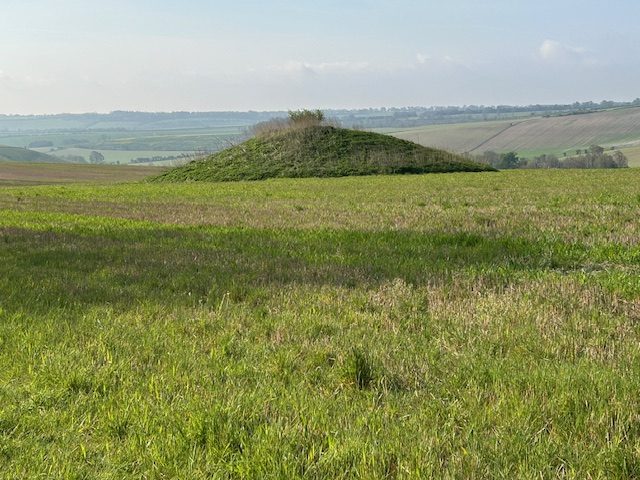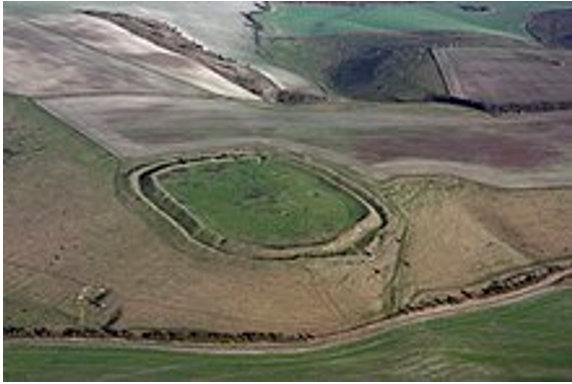Liddington to Aldbourne

Distance: 8.8Km from the Village Inn. It’s 7.3Km if you park at the Ridgeway cross-roads. Height: 132m This is a favourite and regular walk with Rocky, and also my favourite run. It’s not a well-used path and the chance of meeting anyone until you get to the dog walkers of Aldbourne is remote. But the beauty of the rolling hills, the expanse and remoteness and yet so close to home, the downhill sprinting for intermittent fartlek runs and feeling “Chariots of Fire” in your head – it’s truly wonderful. My recommendation is that you plan the route, so you have time to browse and have a cuppa in Aldbourne and then get the bus back. If you have children with you, it can become an adventure. The bus service is reliable in arriving on time, but the frequency is not good. There are no busses on Sunday or Saturday afternoon. During the week they run every hour. Check the timetable first for 46A, 48, 48A and X46 on https://www.swindonbus.co.uk/services If you don’t trust the reliability of the bus (!), you could get the bus from Liddington to Aldbourne and walk back. The walk starts at the Village Inn. Turn left and go up The Street to the end of the road. There’s little traffic on this road. At the top of the Street be careful crossing the B4192. You’re aiming for a footpath sign on the far side of the road. It’s a bit bent at the present but it’s on the list for beautifying this part of the village. Go into the field and turn left. This is a permissive path. There was a change of owners recently and the new farmer has very kindly agreed to keep the permissive path. This will take you to the M4 bridge. Walk inside the barrier and there’s a safe footpath on the verge beyond the bridge that will take you to the crossroads. NOTE: If you are unsure about this part of the walk from the village, you could take your car and park on the right at the crossroads. The walk turns sharply away from the noise of the road by a hedge and leads up a short slope to a place worth stopping to catch your breath. You can see the snake of traffic on the M4, Fox Hill where the phone mast is, several dwellings towards the Liddington Hotel and the Burj, a fine Indian restaurant. The Burj used to be known as the Shepherds Rest pub, and it really irritated me as there was no apostrophe in the name. Was it one shepherd or multiple shepherds? Another conversation with the kids! Continue over the Ridgeway road on the right-hand side of the road. Just beyond the large roadway sign you’ll see a marker for the right of way on the other side of the road. Be careful crossing the road and you’re into the field. The path is marked to your right. Don’t rush though, as a few steps along you’ll see a fox hole under the path. Lots to chat to kids about there! Keep walking and soon you’ll move away from the B4192 and you can let your dog and children loose. You have a good view of Manor Farm. Robert and Charley Bland are regulars in the Village Inn and they can tell a story or two. Go through the next gate and enjoy this lovely track. Even after winter rain, it’s always dry and you can see why it appeals to a runner. In the images below, on your left, you’ll see two gorgeous deciduous woods, called The Moon and the Half Moon. I had the pleasure of running through them some years back before Robert reminded me that they were private! I have fond memories of them, and even based a short story on the Half Moon. As this walk was photographed in April, you won’t see the woods in their glory yet. The track steepens a bit here as you look down on Liddington Warren Farm which has facilities for music events and weddings and is farmed by the Ford family. You’ll also see sheep so be careful with your dog. I like this sign. It shows respect and is caring – so different to many “keep out of here” aggressive signs. You now come to another circular gate. Liddington Hill is off to your right and will soon be out of sight. Go left for about a hundred metres and there’s a signpost to go right. Before you turn right, enjoy the view towards the motorway, the silent lines of traffic snaking the brow. Beyond the gate there’s a lovely deciduous wood. A local told me the farmer doesn’t mind people strolling in there and coming out again about a hundred metres up the hill – which is my way. This could be a truffle wood. In England, truffles are mostly found near the roots of oak, hazel, beech, and birch trees and this is a perfect spot. Truffles are mycorrhizal with these tree species, meaning they form a symbiotic relationship with the roots, benefiting both the fungus and the tree. A friend of mine spent a year training his spaniel to sniff truffle oil. He’d dig a hole and put truffle oil in it in and the spaniel was on it so quickly. It was very impressive. He came up here to try the spaniel out on these woods. The spaniel was perfect on truffle oil but not so great on digging for truffles. They’re still safe. You’re on Sugar Hill now and the beginning of the Barrows that are common around Aldbourne. As you descend, on your right there’s a small mound. This is a bowl barrow about 3m high and 23m in diameter. Most bowl barrows date from the period 2400-1500 BC. The site was partially excavated by Canon Greenwell, a prolific excavator of barrows, between 1885 and 1890. Finds included the cremated remains of an
Liddington Hill and Clump

Distance: 7.5K Height: 190m This is one of my favourite walks with several opportunities to deviate or turn back at any stage if the weather is inclement, or the kids complain, or you’re huffing and puffing and decide you’ve had enough. On a fine day, it’s a glorious walk. HOW TO USE THE MAP The red line indicates the walk. Click on the 2D map. It will take you to the Ordnance Survey where you have more detail. You can have fun with several options if you have a subscription – such as the “Fly-through.” Start by heading along the Street to the B4192. Cross over into Church Road. You can walk up by the Village Hall and into the graveyard where there’s a permissive path. I prefer to go to the top of Church Road and on to the playing field that way. Let the dead rest. Either way, at the exit from the graveyard in the playing field, go through the swing gates and walk to the right of the playing field. There are delightful views from this path, so take them in. There’s no rush. The walk turns left with overhanging branches as if you’re in a tunnel – just like Alice in Wonderland. In the autumn this is the place to pick crab apples on the left and sloes on the right. At the bottom there’s another swing gate and you’re into an open space. The famous sheep who keep escaping are now on your left and well tethered. When they’re not there that little valley is lovely to explore. You’re bound to see roe deer and rabbits and I’ve often seen a kestral. Continue down the track to your right. You’ll see some containers where the clay-pigeon guys shoot at 11am every second Sunday. If you’re walking on that Sunday, there’ll be a bell to let them know. They’ll stop and bid you good morning. If you fancy, ask for Bill Crowley and tell him I sent you. Ask if you can observe and he may even give you instruction and a few shots. The path goes to the right. It’s usually a bit muddy there. You’ll come to a farm track. Go left at the signpost towards the motorway. If this is your first visit, be prepared for the cave drawings under the bridge. I think they’re fabulous. I met the artist there a while back and he was so excited about his work it was contagious. Sometimes it’s wet underfoot in the tunnel. One time, I tried walking on the wall on the right. Great fun for the kids, silly for adults. I got half-way, lost my balance and in the kerfuffle of a huge splash, plus profanity at my sodden dignity, Rocky ran off. Beyond the tunnel, a rope over a metal rod is on the right of the gate. Take a moment to consider what you do next. In summer, the field in front of you may have horses or cattle. They are used to people and won’t bother you so you can walk straight on. If you’re anxious, I suggest you go immediately left and up the bank to the fence-line. The animals won’t follow you and you have an escape gate about half-way into the next field. If you have a dog and there are cattle there, let your dog off the lead. The cattle will only be interested in the dog, and it can scarper between their legs. If you keep your dog on the lead or lift it up into your arms, you’re looking for trouble. Don’t do it. Enjoy the walk up the field to the Ridgeway Road. Don’t go through the gate. The official path is to your left and through a swing gate. Put your dog on a lead here and watch the kids, as this road has fast cars. . On the far side of the road there’s a gate which will not open. To the right of the gate, you can lift the wire, hoosh your dog through and then climb over. You’re now on a permissive path so stick to the path. All the paths on the Hill are permissive paths, thanks to Farmer Peploe. Show appreciation by avoiding the animals and being aware of litter. It’s a steep path, really the only challenge on this walk. Take your time and stop to look back. I’m always fascinated at how much height you gain in only a few minutes of walking here. There may be sheep in the field so put your dog on a lead. At the top, there’s another swing gate and you have choices. If you go through and turn immediately left you can walk along the fence to the Clump, about five minutes away. OPTION Otherwise, you can cut the walk short. Don’t go through the swing gate. Turn right instead and walk along the fence on the permissive path to Liddington Fort. It’s about 200m to the next gate into the fort. THE CLUMP Let’s start with the Clump. It’s an iconic area of trees which you can see coming from London on the M4 or from the train into Swindon. I always get a lift from it, nearly home now. The concrete bunker is from World War II. During the war soldiers managed a Starlight Decoy bunker from here, placing beacons and fires around the top of the hill. The bunker has a central passage with the control room on the left and a hatch in the roof. The generators were in the room on the right. The soldiers distracted Luftwaffe bombers from hitting the railway works in Swindon. Usually on a bombing raid, which was normally at night, small incendiary bombs would be dropped on the target by a Luftwaffe plane. This would guide the bombers in. The Starlight Decoy encouraged bombers to bomb the hill instead. There are a few signs on drone videos of bomb craters, though most have been filled in.


